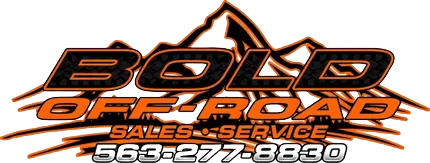UTV Winter Maintenance Checklist for Iowa Riders
How to Get Your UTV Ready for Iowa Winters
Riding in Iowa winters can be fun. It can also be harsh on your UTV. If you take a few steps now, your machine will last longer, start easier in the spring, and cost you less in repairs. Use this checklist in late fall or early winter, before deep cold and snow set in.
“Your
UTV is your investment,” says Dave Barrette, owner of Bold Off Road. “If you skip winter care, you pay for it later.” He adds, “Iowa riders must protect their machines through freeze and thaw or face rust and damage you cannot see until it is too late.”
We’ve broken the checklist into four phases: preparation, winterizing, storage, and spring reactivation.
Preparation (Before Deep Freeze)
• Inspect the fluids. Check engine oil, coolant (antifreeze), brake fluid, transmission/differential fluids. Top off or replace as needed.
• Switch to winter grade oil. Use oil that flows better in cold so your engine spins freely.
• Fuel care. Fill your tank, add a quality fuel stabilizer, then run the engine a few minutes so stabilizer circulates.
• Change filters. Replace or clean the air filter, fuel filters, and oil filters.
• Check tires and pressure. Cold air drops tire pressure. Inflate to correct PSI. Inspect tread and look for cracking.
• Brake and clutch inspection. Check pads or linings, look for leaks in brake lines, test clutch action.
• Inspect drivetrain parts. Check CV joints, boots, U joints, belts, and axles for wear, cracks or damage.
• Grease all fittings and joints. Grease suspension, bearings, pivot points, steering linkage.
• Check electrical system. Inspect battery, wiring, connectors. Clean corrosion.
• Test lights, switches, wiring. All should work including front, rear, and accessories.
• Clean the UTV thoroughly. Remove mud, grime, debris, especially from undercarriage and hidden crevices.
Winterizing (Shutdown Tasks)
• Drain fuel lines or run engine to empty. This reduces stale fuel and moisture buildup.
• Fog the engine (if allowed by your model). Some engines benefit from fogging oil to protect metal. Check your owner’s manual first.
• Disconnect the battery. Remove it from the UTV and store it indoors in a warmer place.
• Charge battery or use a tender. Keep it topped off over winter.
• Raise or support the UTV. Use blocks or stands so weight is off the tires and suspension.
• Plug exhaust or openings. Use steel wool or breathable tape to avoid rodents getting inside.
• Cover with breathable tarp or UTV cover. Do not wrap with plastic that traps moisture.
• Store indoors if possible. A dry, sheltered space is best. If outdoors, choose a cover and spot that sheds snow and protects from wind.
Storage Period (While It Sits)
• Monitor battery level. If you use a tender, check it periodically.
• Watch for rodents. Small animals try to build nests inside.
• Check your cover. Make sure it is not torn, sagging, or collecting water or snow.
• Ventilation. Occasionally allow air to flow under the cover if safe.
• Avoid starting unless needed. If you start it occasionally, run it fully to operating temperature so condensation clears.
Spring Reactivation (After Winter)
• Reconnect battery. Ensure it is fully charged and terminals are clean.
• Inspect all fluids again. Change coolant, oil, and filters if needed.
• Check brakes, tires, drivetrain again. Look for signs of damage or seizing.
• Inspect all wiring and connectors. Snow melt and rodents may affect wires.
• Test electrical systems, lights, gauges.
• Remove plugs or covers from exhaust.
• Do a short test run. Let engine warm, test brakes, shift through gears, check for leaks.
Tips for Iowa’s Conditions
• Iowa winters throw cold, snow, ice, and salt. The soil, moisture, and freeze thaw cycles demand extra care.
• When riding, avoid deep puddles of salt water. Salt speeds corrosion.
• After a winter ride, clean and dry the UTV before it sets overnight wet.
• Keep spare belts, fuses, and basic repair tools with your winter kit.
• Use rust inhibitor sprays on exposed metal after cleaning.
• Run your engine periodically if you plan occasional winter use, so seals do not dry out.
FAQ
Q: When is the best time to do this checklist?
A: Do it once before the first deep freeze. Late fall, before heavy snow, is ideal. You can do touch ups midwinter if conditions allow.
Q: Should I fog my engine?
A: Only if your engine manual allows fogging. Some models support leaving a protective coating of oil. Others do not need it.
Q: Can I leave the UTV outside with a cover?
A: You can if indoor storage is not possible. But use a good breathable cover, elevate the unit, and check it periodically.
Q: How often should I run the engine during winter?
A: If you must, run it long enough to reach full temperature. Do not just fire it briefly. That can cause internal condensation.
Q: What kind of battery tender should I use?
A: Use a smart 1–2 amp float charger that adjusts automatically so your battery stays at a safe charge without overcharging.
Q: Must I drain fuel?
A: Draining fuel lines or running fuel dry is optional. If you use fuel stabilizer and store a full tank to reduce condensation, you may not need to fully drain.
Q: How important is grease?
A: Very important. Exposed joints shrink, stiffen, or corrode in cold. Greasing them helps them move freely when spring returns.
Q: Do I need to jack up the UTV?
A: It helps prevent flat spots on tires and stress on suspension parts. If possible, lift or support so weight is off tires.
At Bold Off Road in Coggon, IA, we follow these steps ourselves and we encourage you to do the same. We have seen too many UTVs damaged simply because someone skipped winter upkeep.

